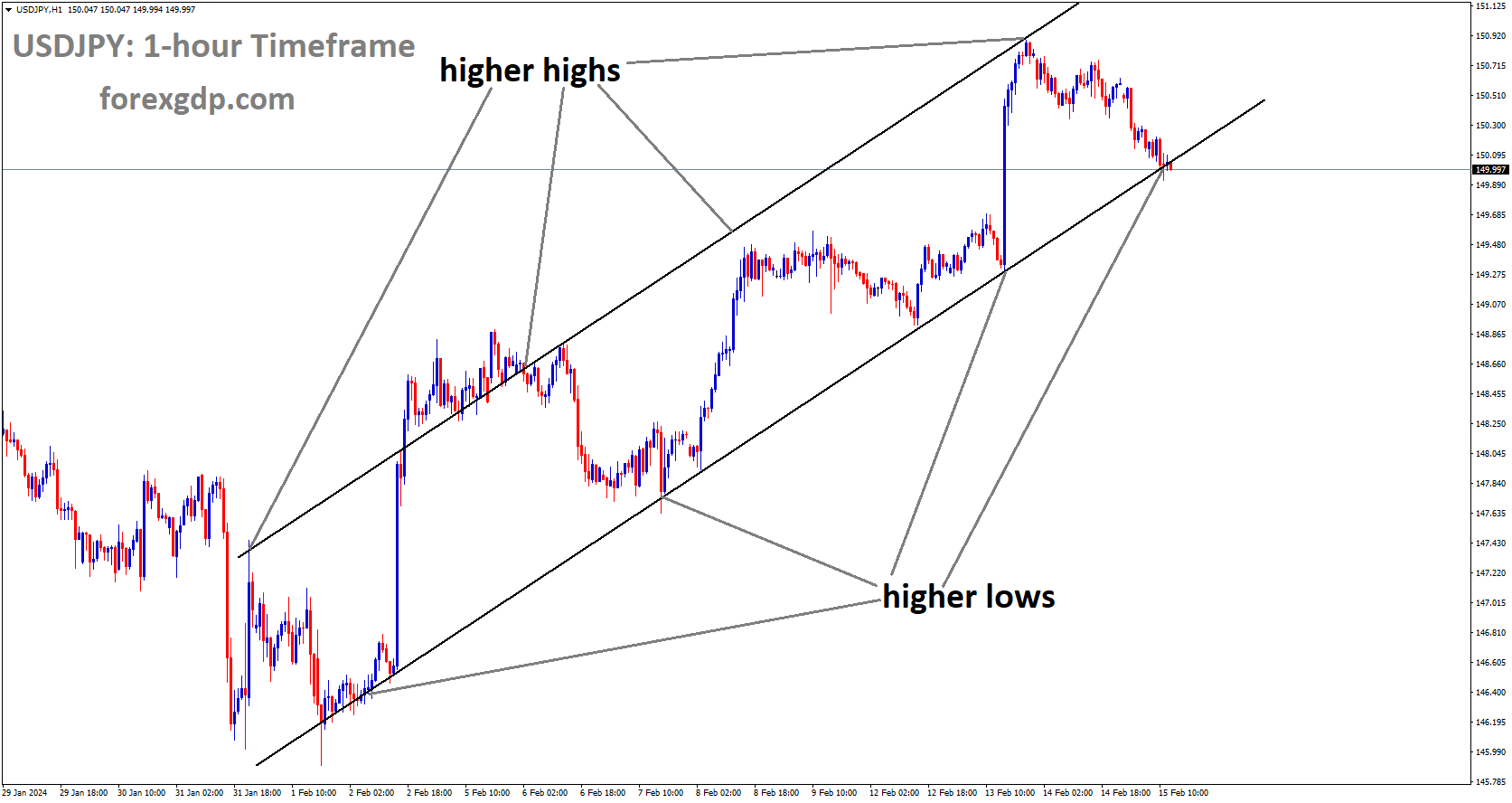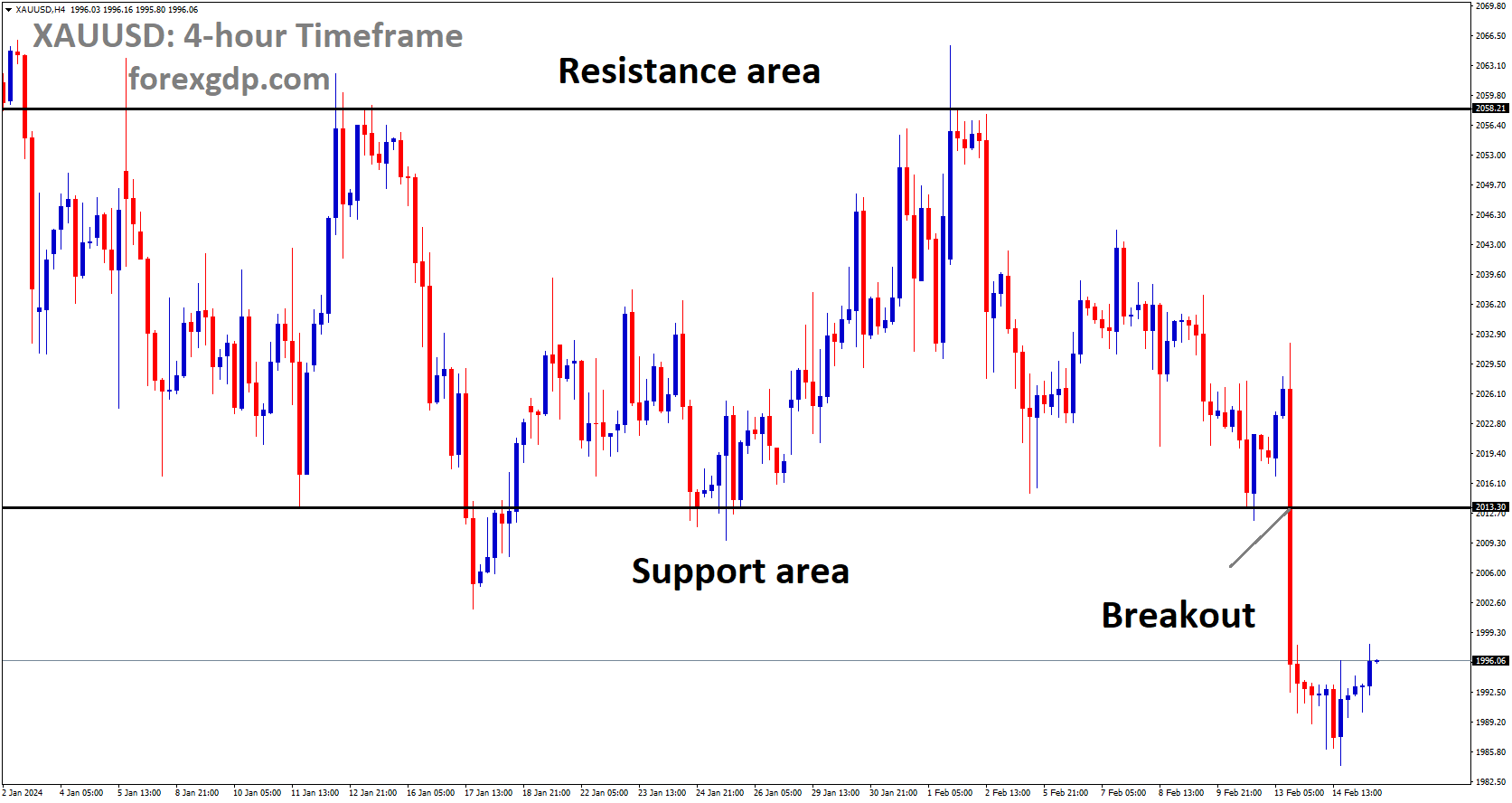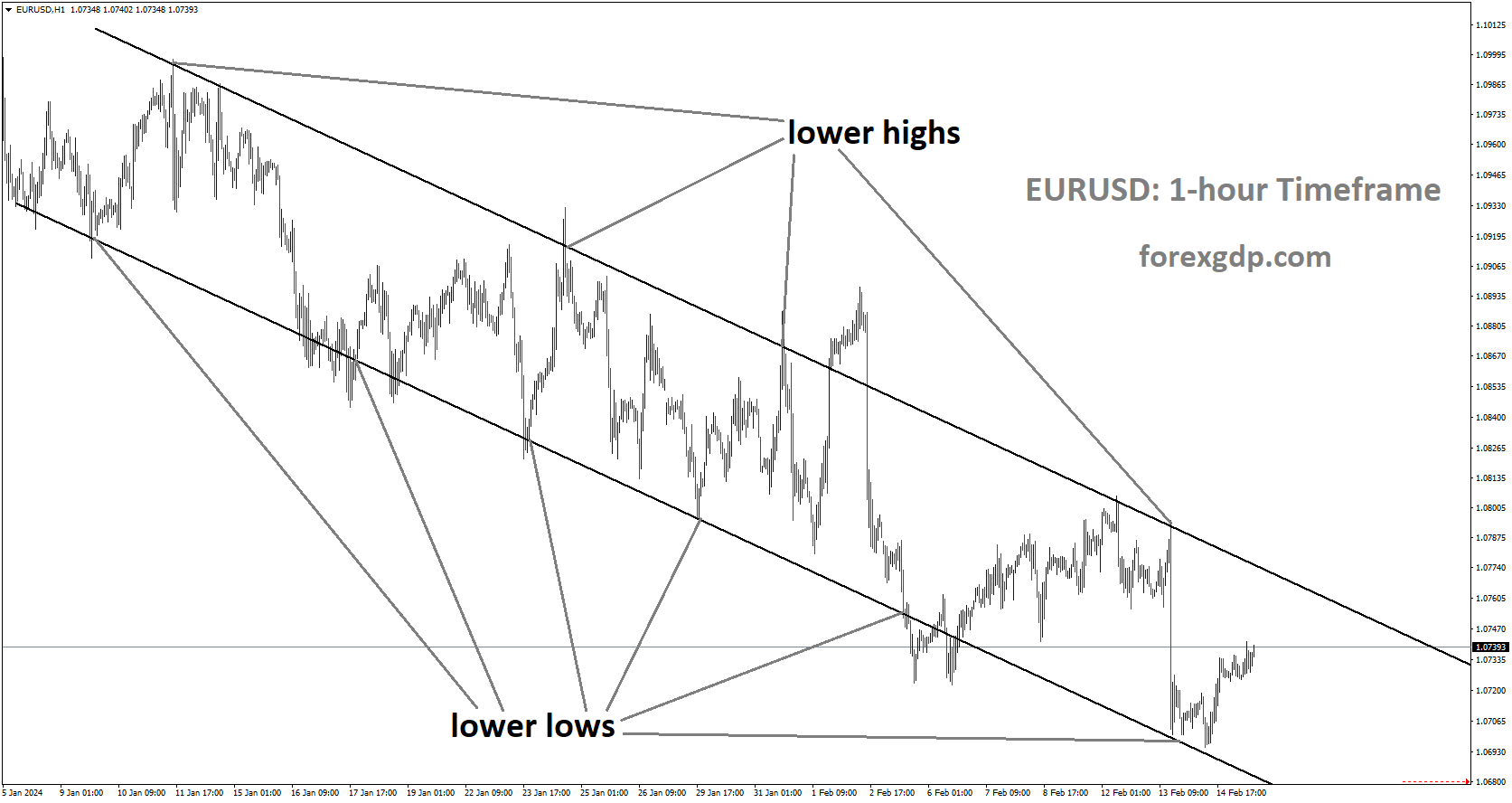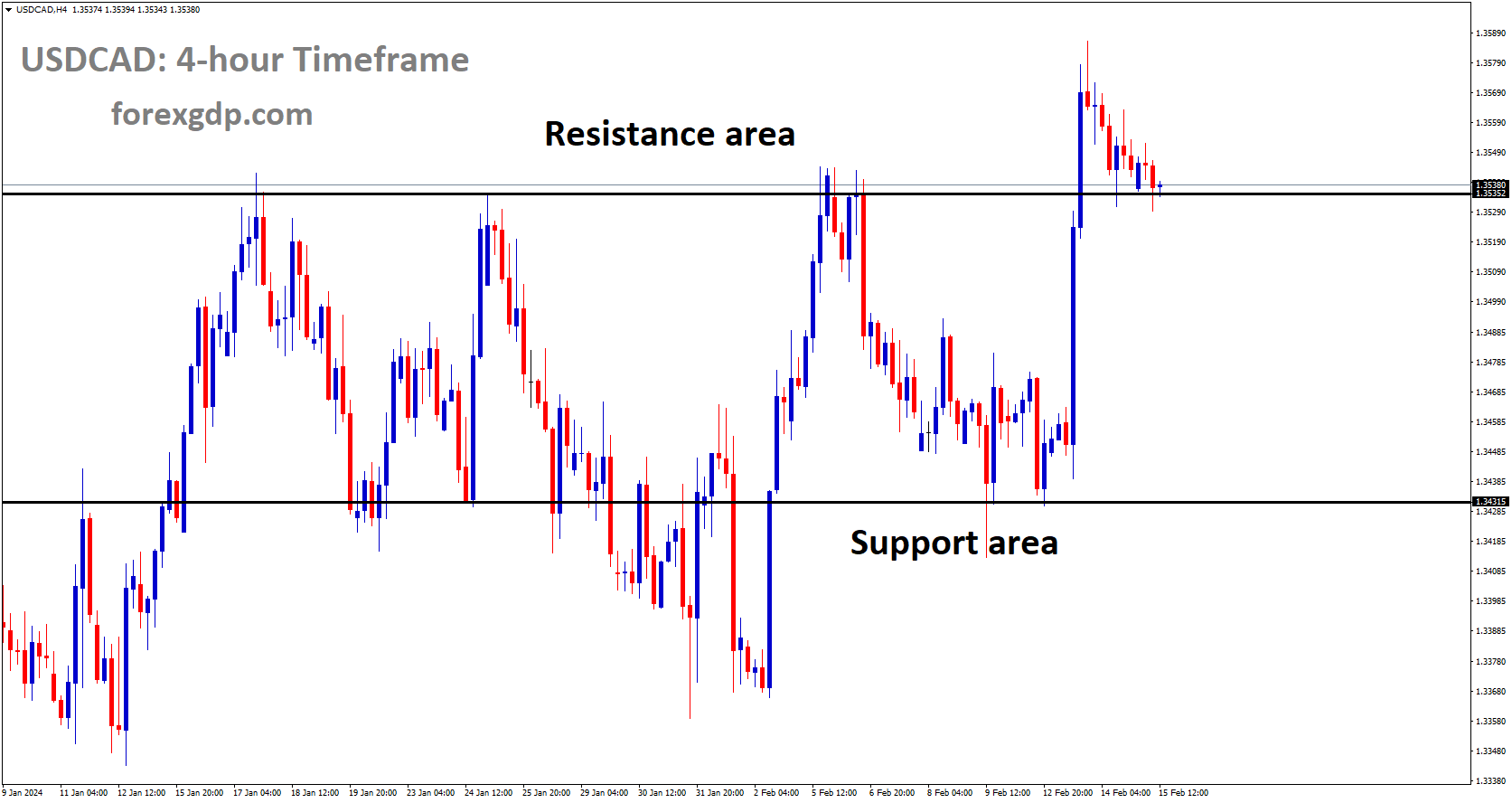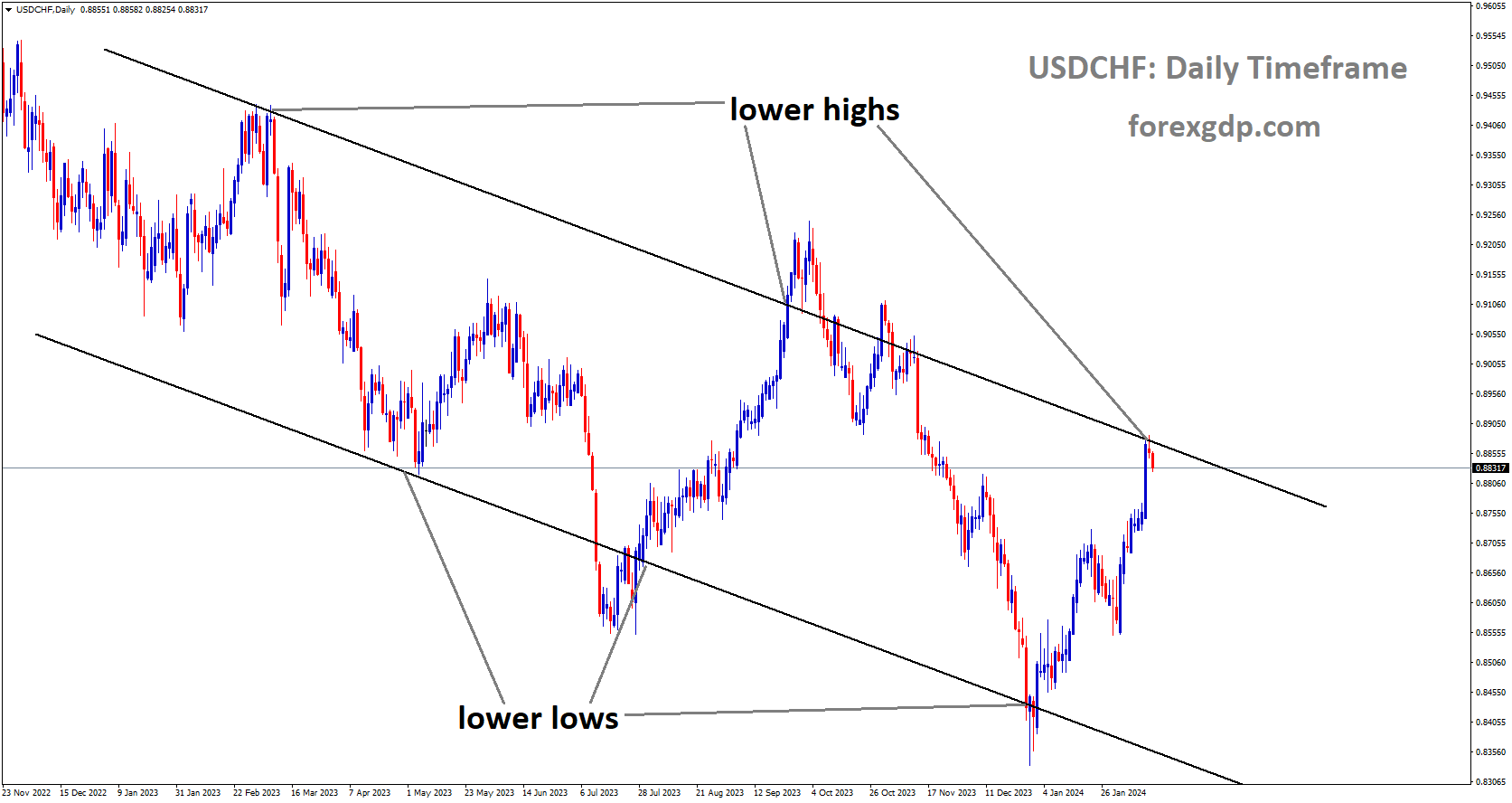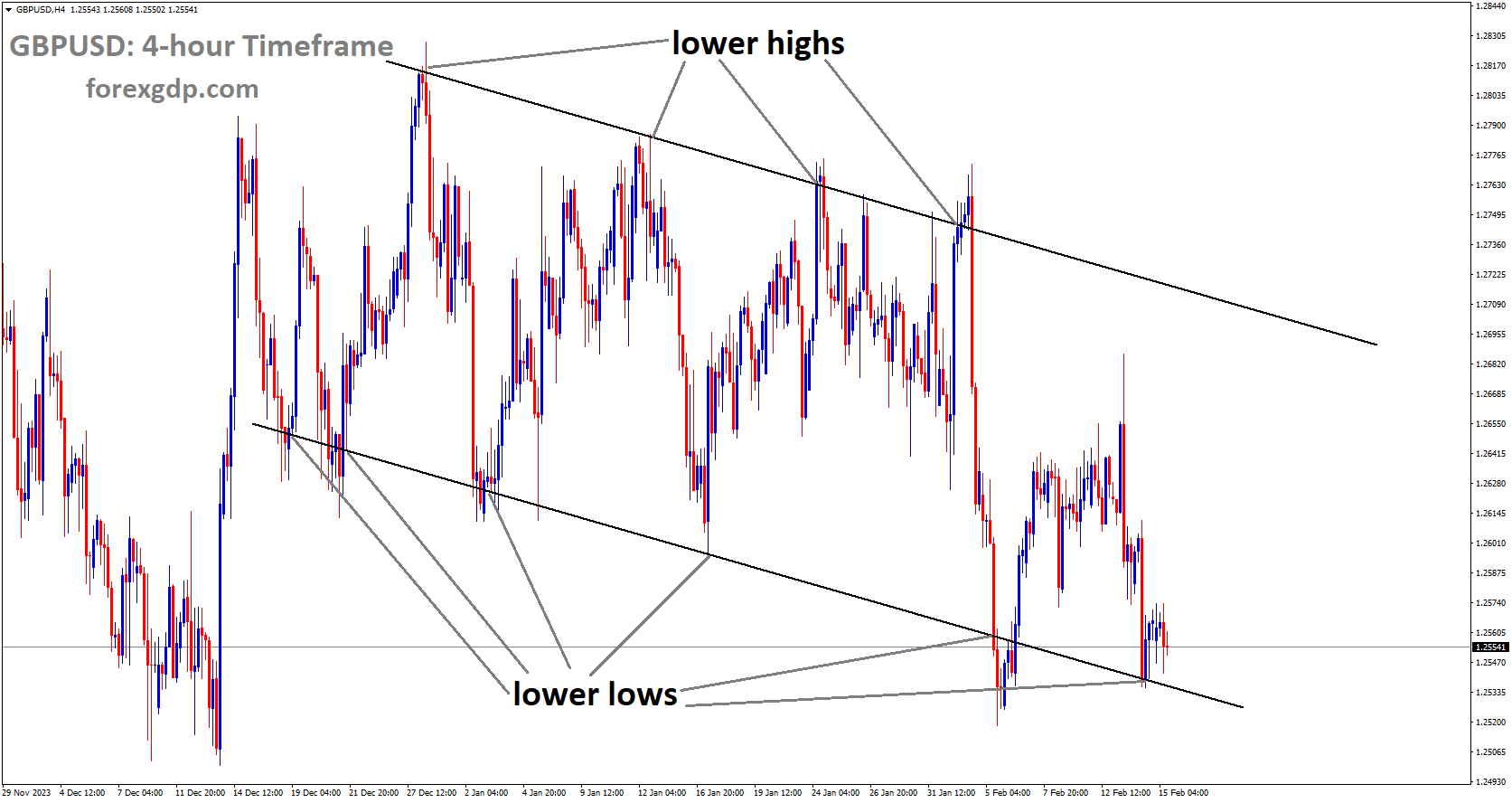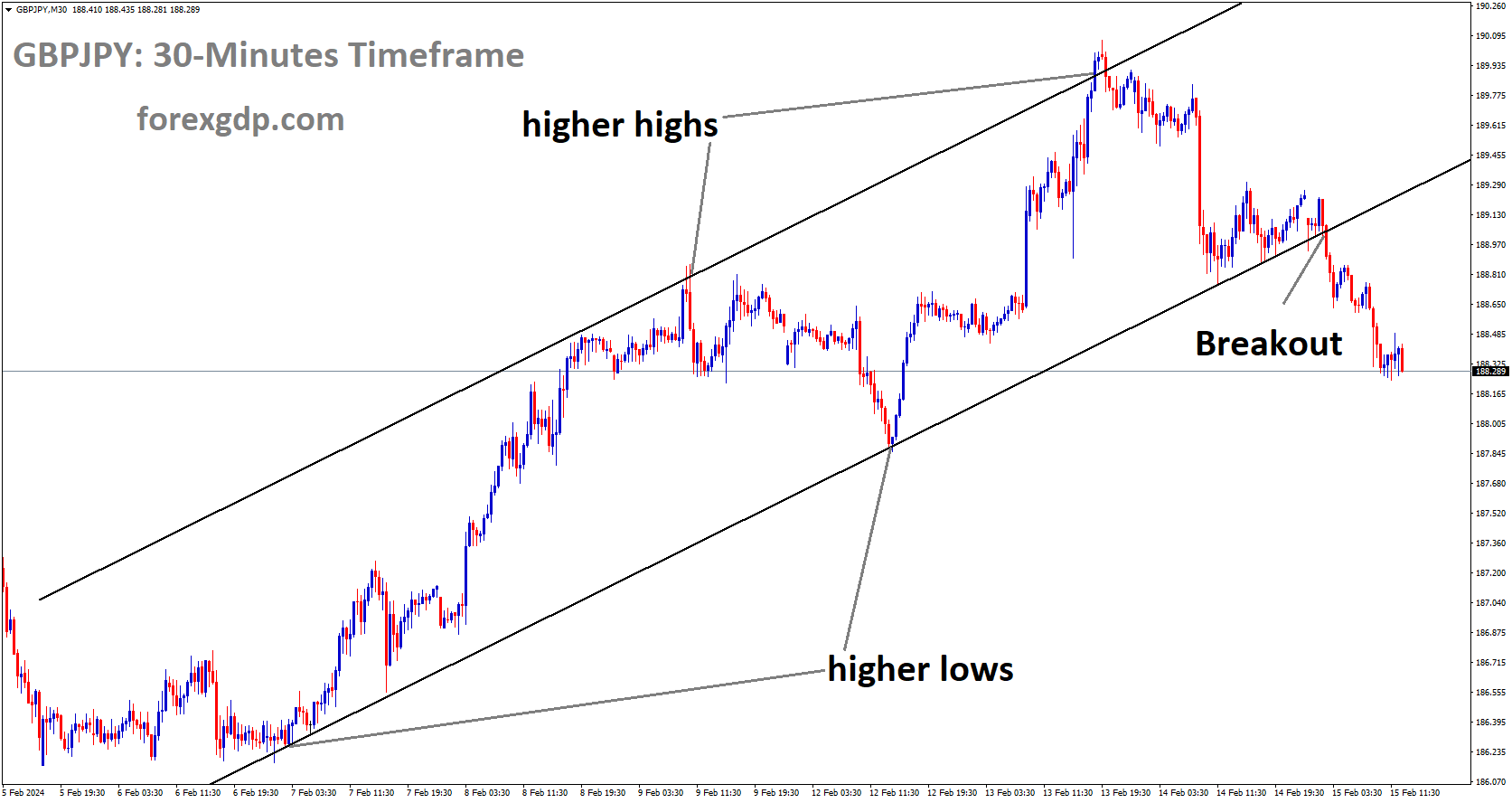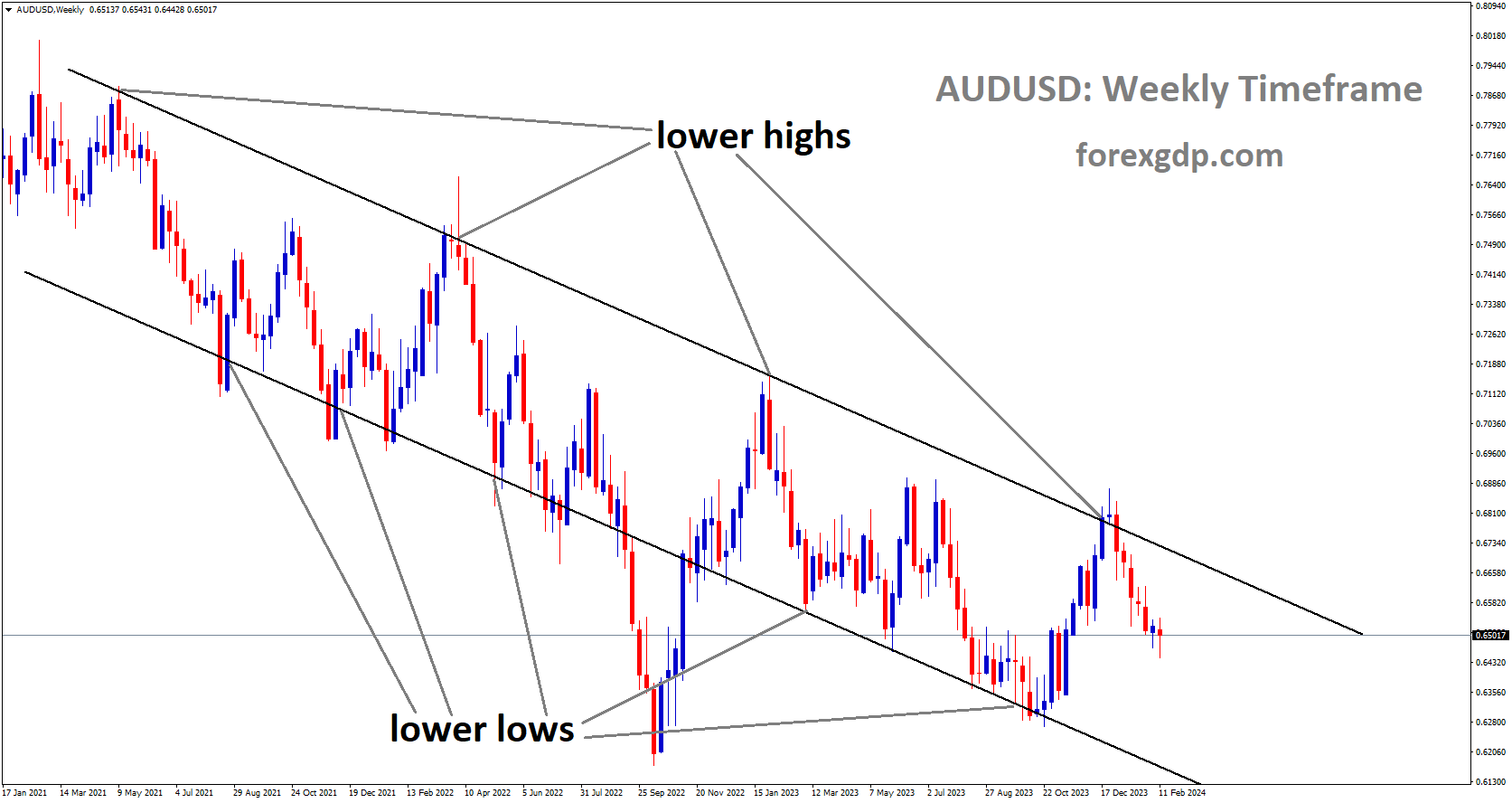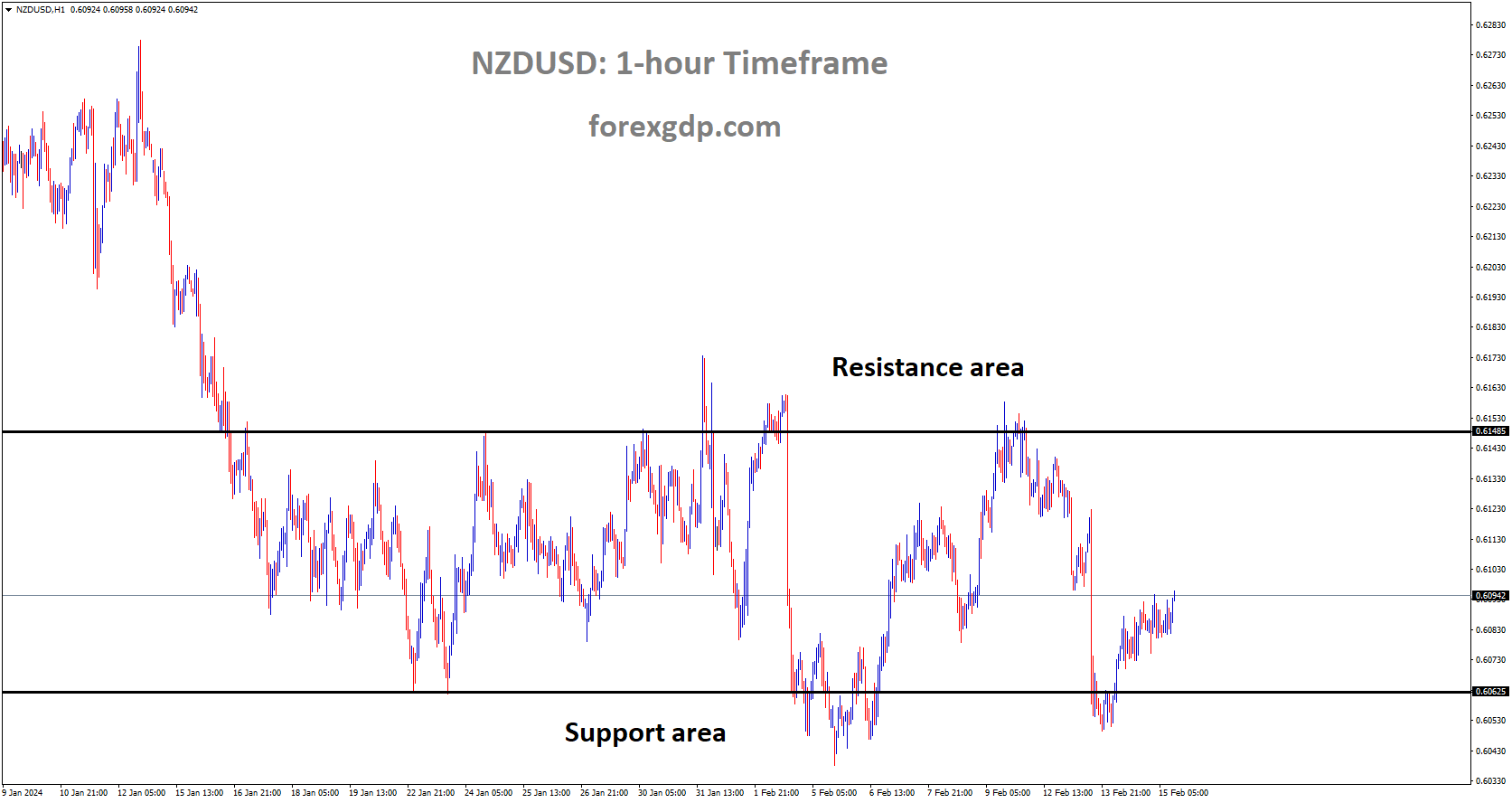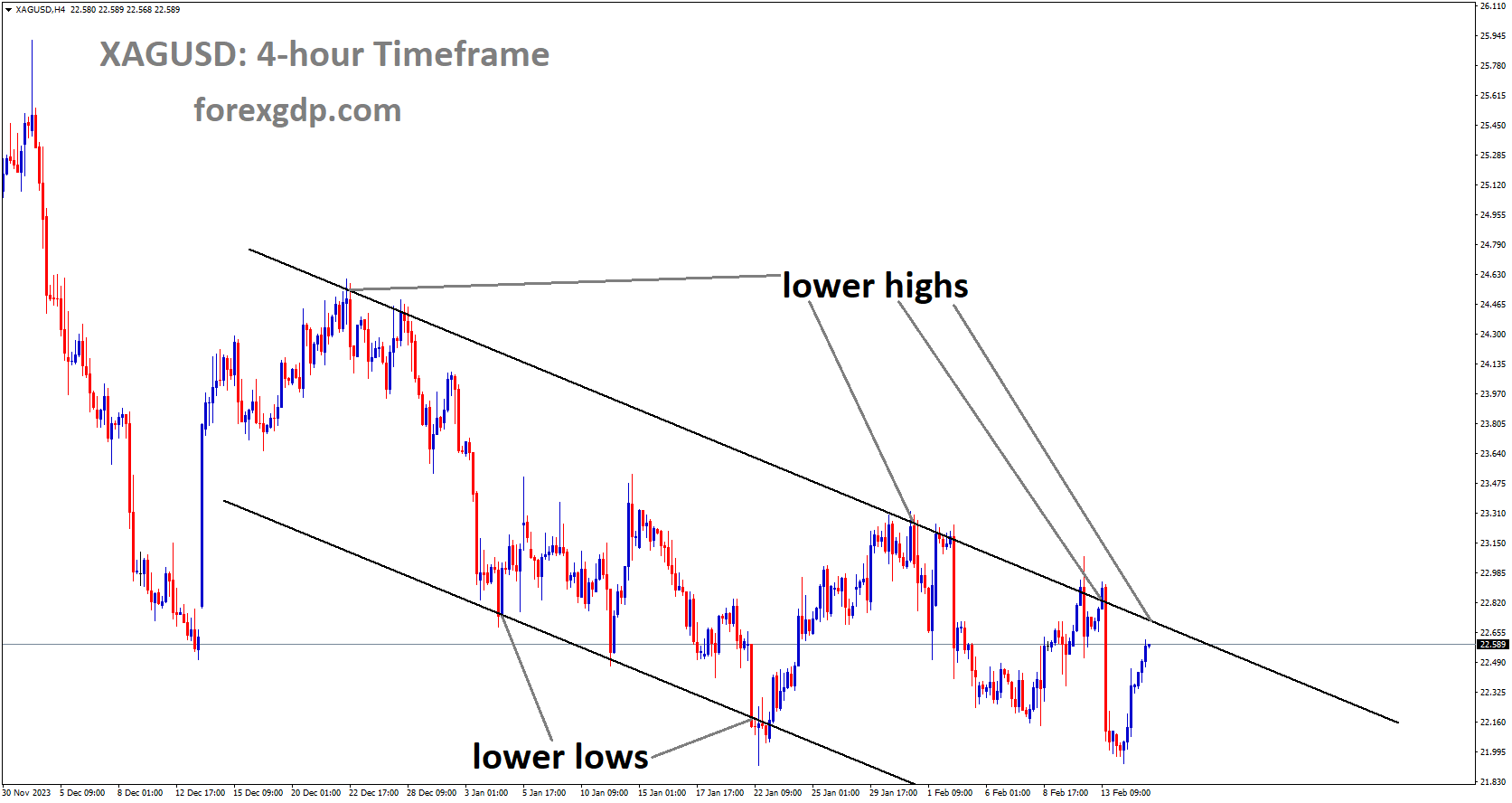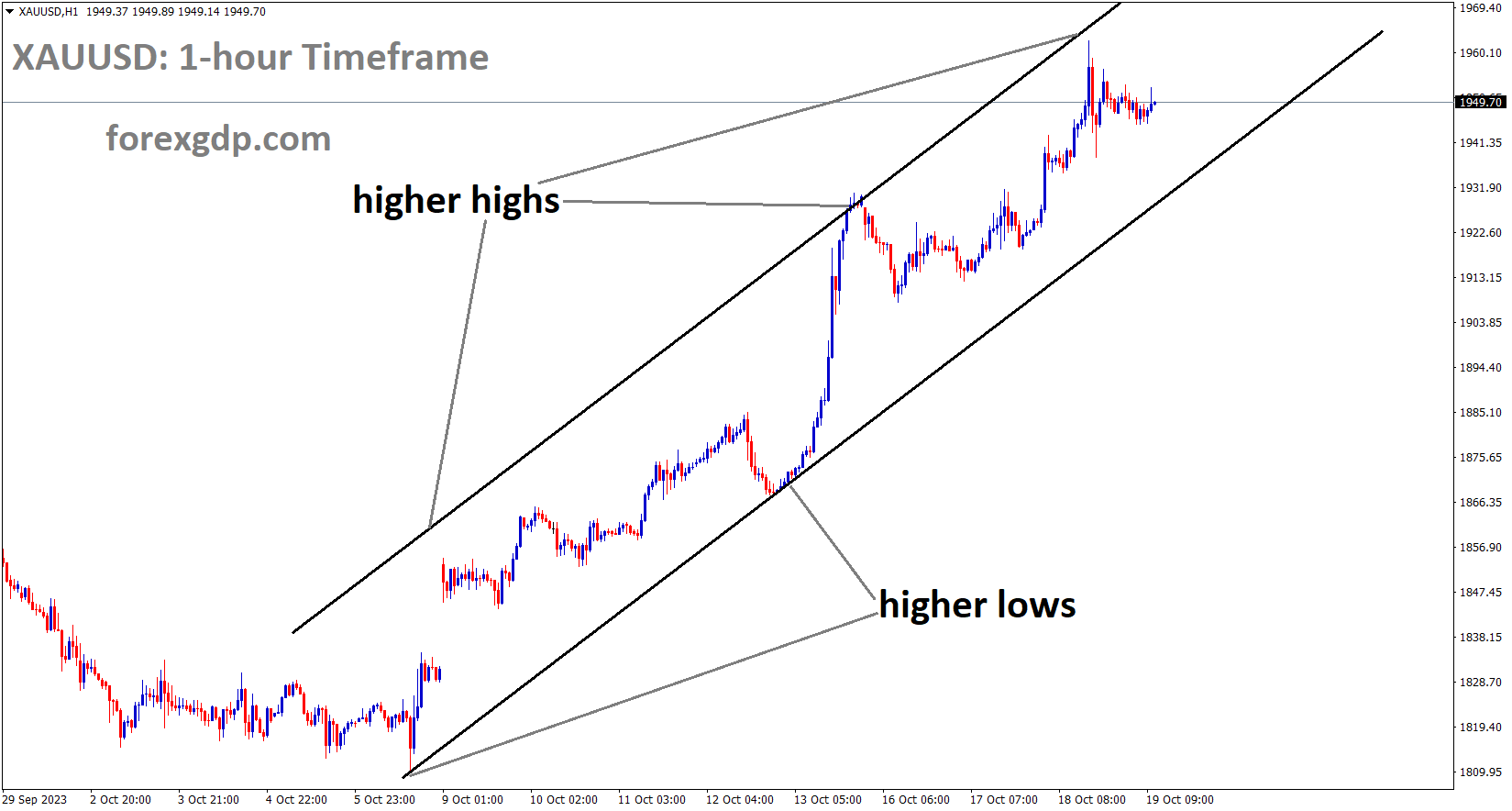USDJPY is moving in Ascending channel and market has reached higher low area of the channel
USDJPY – Japan’s Weak GDP Data and Yen Dynamics
Japan’s Disappointing Fourth Quarter GDP Figures for 2023:
Japan recently disclosed fourth-quarter GDP figures for 2023, which fell below expectations, indicating weaker economic performance.
Despite minimal movement in the USD/JPY currency pair immediately following the release, the data implies a negative outlook for the Japanese yen.
The underwhelming GDP figures offer fewer incentives for the Bank of Japan to consider exiting its accommodative monetary policy stance in April.
Implications for Bank of Japan’s Policy Settings:
The lackluster economic growth depicted by the GDP data suggests that the Bank of Japan is likely to maintain its super-loose monetary policy settings for an extended period.
With subdued economic activity, policymakers may opt to prioritize measures aimed at stimulating growth and supporting financial stability, rather than tightening monetary policy prematurely.
Potential Impact on Japanese Exports and Currency Preferences:
Given that exports have traditionally been a key driver of Japan’s economic growth, the disappointing GDP figures could prompt Japanese authorities to reassess their stance on currency valuation.
A weaker yen may be perceived as beneficial for Japanese exporters, as it enhances the competitiveness of their goods in international markets, potentially stimulating export-led growth.
Market Response and Currency Dynamics:
Despite the negative implications of the GDP data for the yen, the USD/JPY exchange rate has shown limited movement immediately following the release.
Market participants may be assessing the broader economic context and awaiting further developments, including central bank responses and additional economic indicators, before adjusting their currency positions.
Considerations for Investors and Policy Observers:
Investors and policy observers are closely monitoring Japan’s economic performance and its implications for monetary policy decisions.
The weak GDP figures underscore the challenges facing Japan’s economy and highlight the importance of policy measures aimed at promoting sustainable growth and addressing structural vulnerabilities.
Global Economic Context and Interconnected Markets:
Japan’s economic performance and policy responses are interconnected with global economic trends and market dynamics.
Developments in Japan’s economy, including GDP data releases and monetary policy decisions, can influence investor sentiment and currency movements beyond the domestic market.
Future Outlook and Policy Direction:
The outlook for Japan’s economy and currency remains subject to various factors, including domestic policy responses, global economic conditions, and geopolitical developments.
Continued monitoring of economic indicators and policy announcements will be essential for assessing the trajectory of Japan’s economic recovery and its implications for currency markets.
GOLD – Understanding Factors that Impact Gold Prices
US Inflation Data and Federal Reserve Policy Stance:
The recent release of upbeat US inflation data for January has reinforced the cautious approach of the Federal Reserve towards implementing rate cuts throughout 2024. The Fed’s monetary policy decisions are intricately linked to economic indicators, particularly inflationary trends, which shape its stance on interest rates. Positive inflation figures signal a potentially robust economy, prompting the Fed to adopt a vigilant stance on potential rate adjustments in response to evolving economic conditions.
XAUUSD has broken box pattern in downside
Geopolitical Tensions in the Middle East:
Escalating geopolitical tensions in the Middle East, notably exemplified by rising conflict in the region, have significant implications for gold prices. Gold, often regarded as a safe-haven asset during times of geopolitical uncertainty, stands to benefit from heightened tensions, as investors seek refuge in assets perceived as stable and resilient. Ongoing conflicts and geopolitical instability in the Middle East contribute to market volatility and underscore the role of gold as a hedge against geopolitical risk.
Impact of US Retail Sales Data:
Market observers are closely monitoring US Retail Sales data, as it holds potential implications for gold prices. Stronger-than-expected retail sales figures may exert selling pressure on gold, counteracting other factors supporting its price, such as geopolitical tensions or inflation data. Retail sales data serves as a barometer of consumer confidence and economic vitality, influencing market sentiment and investor behavior towards gold and other commodities.
US Dollar Index and Treasury Yields:
Fluctuations in the US Dollar Index, which measures the strength of the USD against a basket of global currencies, alongside movements in US Treasury yields, play a pivotal role in shaping commodity markets.
A decline in bond yields, coupled with a weaker USD, may provide support to commodities, including gold, by enhancing their attractiveness relative to other investment options.
Conversely, a strengthening USD and rising bond yields could exert downward pressure on gold prices, as investors pivot towards higher-yielding assets and away from non-interest-bearing commodities.
Federal Reserve’s Policy Outlook:
Recent statements from Federal Reserve officials, including Fed Vice Chair Michael Barr and Fed Chair Jerome Powell, underscore the central bank’s cautious stance on monetary policy adjustments.
The Fed remains committed to data-driven decision-making, awaiting further positive economic indicators, particularly regarding inflation, before considering rate cuts.
Market sentiment, as reflected in the pricing of rate cut probabilities, has shifted in response to Fed communications, with expectations now leaning towards a potential rate cut in June rather than May.
Geopolitical Developments in the Middle East:
Recent military actions in the Middle East, notably Israel’s airstrikes in response to attacks from Lebanon, have escalated geopolitical tensions in the region.
Heightened geopolitical uncertainty contributes to market volatility and underscores the role of gold as a safe-haven asset, with investors seeking refuge from geopolitical risk.
The ongoing conflict in the Middle East underscores the dynamic interplay between geopolitical developments and commodity markets, shaping investor sentiment and asset prices.
Upcoming Economic Indicators and Federal Reserve Speeches:
Market participants are awaiting the release of various economic indicators, including the US Philly Fed Manufacturing Index, Industrial Production, and weekly Initial Jobless Claims.
Additionally, speeches from Federal Reserve officials, such as Bostic and Waller, are anticipated to provide further insights into the central bank’s policy outlook, influencing gold prices accordingly.
These events serve as critical drivers of market sentiment and investor behavior, shaping the trajectory of gold prices in the near term.
EURUSD – ECB Policy, US Data, and Currency Movements
ECB President Lagarde’s Commitment to Data-Driven Approach:
ECB President Lagarde reiterated the central bank’s commitment to a data-dependent approach to monetary policy.
This underscores the importance of economic indicators in shaping the ECB’s decisions and highlights the central bank’s responsiveness to evolving economic conditions.
EURUSD is moving in Descending channel and market has rebounded from the lower low area of the channel
US Economic Docket Highlights Retail Sales and Initial Jobless Claims:
The US economic calendar will feature key data releases, including Retail Sales and weekly Initial Jobless Claims.
These indicators offer insights into consumer spending patterns and the labor market health, respectively, influencing market sentiment and expectations regarding economic growth.
EUR/USD Technical Correction Following Tuesday’s Decline:
After experiencing a sharp decline on Tuesday, the EUR/USD currency pair staged a technical correction.
Wednesday’s trading session saw the pair closing in positive territory, reflecting temporary relief for euro bulls.However, the pair continues to face challenges in gathering recovery momentum amid market fluctuations and anticipation of upcoming US data releases.
Challenges for the US Dollar Amidst Improving Risk Sentiment and Lower Treasury Yields:
The US Dollar encountered difficulties in extending its rally from Tuesday, despite stronger-than-expected Consumer Price Index data.
Improving risk sentiment, coupled with retreating US Treasury bond yields, contributed to the USD’s struggle in maintaining upward momentum.
These factors highlight the complex interplay between market dynamics, economic data, and investor sentiment in shaping currency movements and exchange rate trends.
USDCAD – Oil Prices, Market Sentiment, and Interest Rate Expectations
USD/CAD Consolidates Following Recent Declines:
The USD/CAD pair strives to regain stability after a period of decline witnessed in the previous session.
Amidst relatively subdued movement in the US Dollar, potentially influenced by a decrease in US bond yields, the pair exhibits a sense of equilibrium.
USDCAD is moving in box pattern and market has reached resistance area of the pattern
This consolidation phase is observed during the Asian trading session, indicating a pause in the recent downward momentum.
WTI Price Drop Pressures the Canadian Dollar:
The Canadian Dollar faces downward pressure due to the decline in the price of West Texas Intermediate crude oil.
The ongoing trend of decreasing oil prices adds to the weight on the Canadian Dollar, which is typically sensitive to fluctuations in commodity markets.
Despite geopolitical tensions in the Middle East, concerns over an unexpected surge in US crude oil inventories overshadow potential disruptions in supply, contributing to the downward trajectory of WTI prices.
Market Sentiment and Expectations Regarding Interest Rates:
Market sentiment strongly indicates that the Federal Reserve is likely to maintain interest rates at their current level during the upcoming meeting.
According to data from the FedWatch Tool, there is a notable probability, close to 90%, that the Fed will opt to keep interest rates unchanged in March.
Looking further ahead, there is a moderate probability, around 37%, of a rate cut occurring in May. Additionally, there is an increasing likelihood, approximately 53%, of a 25 basis points rate cut taking place in May.
Impact of Improved Risk Appetite and Fed’s Stance:
At present, the 2-year and 10-year US Treasury yields stand at 4.55% and 4.23%, respectively, indicating a decline from previous levels.
Recent remarks by Chicago Fed President Austan Goolsbee emphasize that despite positive consumer price data, the Federal Reserve remains open to the possibility of lowering interest rates in 2024 if deemed necessary.
USDCHF – Currency Moves and Economic Indicators
USD/CHF Declines on Weakening US Dollar and Improved Risk Sentiment:
The USD/CHF currency pair experiences a decline as the US Dollar weakens against the Swiss Franc
The decline is primarily attributed to a decrease in US Treasury yields, indicating reduced demand for the USD.
Improved risk sentiment in the market, characterized by mild remarks from Federal Reserve officials, further contributes to the depreciation of the USD.
USDCHF is moving in Descending channel and market has reached lower high area of the channel
US Treasury Yields and Market Dynamics:
Market dynamics are influenced by the movement of US Treasury yields, with the 2-year and 10-year yields currently standing at 4.56% and 4.23%, respectively.
Traders closely monitor these yields as they serve as indicators of investor confidence and economic outlook, impacting currency valuations.
Assessment of Federal Reserve’s Monetary Policy Outlook:
Investors assess the Federal Reserve’s stance on monetary policy in response to recent economic data and statements from Fed officials.
Chicago Fed President Austan Goolsbee’s comments suggest that despite robust inflation data, the Fed remains open to considering interest rate cuts in 2024 if necessary.
Federal Reserve’s Confidence in Inflation Trajectory:
Federal Reserve Vice Chair for Supervision Michael Barr reaffirms the central bank’s confidence in the trajectory of US inflation, emphasizing the commitment to achieving the Fed’s 2% target.
Barr’s remarks provide insight into the Fed’s assessment of inflationary pressures and its policy stance moving forward.
Downward Pressure on Swiss Franc Due to Slowing Inflation:
The Swiss Franc faces downward pressure as inflation in Switzerland shows signs of slowing down.
January’s Consumer Price Index data reveals a lower-than-expected increase of 0.2%, falling short of market expectations and indicating subdued inflationary pressures.
Annual inflation also decelerates significantly to 1.3%, highlighting concerns about the pace of economic growth in Switzerland.
Upcoming Economic Data from Switzerland:
Market participants await the release of Producer and Import Prices data from the Federal Statistical Office of Switzerland.
Expectations lean towards an improvement in January, with investors keen to gauge the impact on inflationary trends and overall economic performance.
Focus on US Economic Indicators:
Attention is also directed towards upcoming US economic indicators, including Retail Sales data and Initial Jobless Claims.
These indicators provide crucial insights into consumer spending patterns and labor market conditions, influencing investor sentiment and currency market movements.
GBPUSD – Challenges Amid UK Recession and US Data
GBP/USD encounters challenges in finding upward momentum amidst the latest data releases from the United Kingdom. The UK economy faced a setback as it officially entered into a recession during the fourth quarter. This development, coupled with upcoming economic indicators from the United States, holds significant implications for currency markets. Investors are particularly attentive to the Weekly Initial Jobless Claims and January Retail Sales data, which are pivotal in gauging the health of the US economy and its potential impact on currency pairs like GBP/USD.
GBPUSD is moving in Descending channel and market has reached lower low area of the channel
The relative performance of Pound Sterling against major currencies serves as a barometer for market sentiment and economic conditions. Notably, GBP exhibited weakness against the US Dollar, reflecting concerns surrounding the UK’s economic outlook. The Office for National Statistics reported a contraction of 0.3% in Gross Domestic Product for the fourth quarter, cementing the country’s entry into a technical recession following a previous 0.1% contraction in the third quarter.
Amidst this economic backdrop, data on UK Industrial Production and Manufacturing Production provided a mixed picture. While both indicators showed expansion on a monthly basis in December, with Industrial Production increasing by 0.6% and Manufacturing Production by 0.8%, the overall economic sentiment remains subdued due to the recessionary trend.
Looking ahead, market attention turns to the US Department of Labor’s release of weekly Initial Jobless Claims data. Projections suggest a potential uptick to 220,000 in the week ending February 10. The outcome of this release carries significance, as it could sway investor sentiment and influence the trajectory of the GBP/USD currency pair. A larger-than-anticipated increase in first-time applications for unemployment benefits may weigh on the US Dollar, potentially helping GBP/USD mitigate its losses. Conversely, a reading closer to 200,000 could reinforce the perception of tight labor market conditions and lend support to the US Dollar.
Additionally, market participants await the January Retail Sales report from the US. While this data is not adjusted for price changes, any significant deviation from the expected -0.1% could prompt market reactions. However, the impact of this report may be limited unless it diverges notably from market expectations.
Against the backdrop of these economic indicators, US stock index futures trade modestly higher, signaling improved risk sentiment. In the event that risk appetite continues to improve following the opening bell on Wall Street, the US Dollar may face challenges in attracting investors. This dynamic underscores the intricate interplay between economic data releases, market sentiment, and currency movements in the global financial landscape.
The market’s improved risk appetite contributes to a decrease in US Treasury yields, reflecting a shift towards riskier assets.
GBPJPY – Recession Pressures and Policy Uncertainty in the UK and Japan
UK Economic Contraction Fuels BoE Rate Cut Speculation and GBP Pressure:
Recent data from the UK Office for National Statistics reveals an unexpected 0.3% contraction in the economy during the final quarter of 2023, marking the onset of a technical recession.
This decline follows a previous quarter’s GDP drop of 0.1%, heightening concerns about the UK’s economic health and spurring speculation of an imminent rate cut by the Bank of England.
The release of softer consumer inflation figures on Wednesday further solidifies market expectations of monetary easing, exerting downward pressure on the British Pound.
GBPJPY has broken in Ascending channel in downside
Japanese Verbal Intervention and Geopolitical Tensions Bolster JPY:
Speculation surrounding potential intervention by Japanese authorities to counteract the recent weakening of the Japanese Yen lends support to the currency.
Concurrently, geopolitical tensions in the Middle East enhance the JPY’s safe-haven appeal, amplifying its strength and adding selling pressure on currency pairs like GBP/JPY.
Deepening Japanese Recession Raises BoJ Policy Uncertainty:
Preliminary data unveils a more pronounced than anticipated 0.4% contraction in Japan’s GDP during the October-December period, significantly undershooting market expectations of 1.4% growth.
This contraction, coupled with a previous quarter’s steep decline of 3.3%, officially confirms a technical recession in Japan.

The confirmation of a recession intensifies uncertainty regarding the timing of the Bank of Japan’s exit from its negative interest rate policy, casting doubt on future monetary policy decisions.
Exercise Caution Amidst Policy Uncertainty:
With both the UK and Japan experiencing technical recessions, caution is advised when analyzing the near-term trajectory of the GBP/JPY cross.
The uncertain landscape surrounding central bank policies adds complexity to currency movements, necessitating careful assessment before drawing conclusions about potential trend formations.
AUDUSD – Economic Data and Geopolitical Factors
AUD/USD’s Struggle for Buyers:
Despite a slight rebound from recent lows, the AUD/USD pair finds itself grappling with a lack of buyer interest.
During the early stages of the European trading session on Thursday, the pair remains confined within a tight trading range, failing to break through crucial psychological levels.
AUDUSD is moving in Descending channel and market has fallen from the lower high area of the channel
Weight of Disappointing Domestic Employment Data on AUD:
The Australian Dollar faces downward pressure following the release of discouraging domestic labor market figures.
January’s Unemployment Rate climbed to a two-year peak of 4.1%, marking a notable uptick from the previous 3.9%.
Employment growth significantly underwhelmed expectations, with a mere 500 jobs added compared to the anticipated 30,000.
These figures paint a picture of economic slowdown in Australia, denting hopes for further interest rate hikes by the Reserve Bank of Australia.
USD Strengthens Amid Hawkish Fed Expectations:
Bolstered by anticipations of a hawkish stance from the Federal Reserve, the US Dollar maintains its robust position.
Stronger-than-anticipated US consumer inflation data postpone prospects of a Fed interest rate cut, now earmarked for around mid-year.
Futures tied to Fed funds signal decreased likelihood of a rate reduction in March, with a substantial chance of easing by June and the potential for three rate cuts before year-end.
Heightened geopolitical tensions, particularly in the Middle East, bolster the USD’s allure as a safe-haven asset, further reinforcing its dominance over risk-sensitive currencies like the Australian Dollar.
Geopolitical Unrest Adds to Market Uncertainty:
Recent military escalations between Israel and Lebanon escalate geopolitical tensions, introducing added uncertainty into the market.
Concurrent negotiations for a ceasefire between Israel and Hamas in Gaza compound the geopolitical landscape with additional complexities.
These developments, coupled with expectations of a protracted period of US interest rate hikes, foster a climate of cautious investor sentiment, dampening enthusiasm for bullish positions on the AUD.
Awaiting US Economic Data:
Market participants eagerly await the release of pivotal economic data from the United States.
Key indicators including monthly Retail Sales, the Empire State Manufacturing Index, Weekly Initial Jobless Claims, the Philly Fed Manufacturing Index, and Industrial Production data are awaited with bated breath.
These data releases hold the potential to offer short-term trading opportunities and exert significant influence over the trajectory of the AUD/USD pair.
NZDUSD – Central Bank Insights, Economic Data Awaited: Impact on NZD/USD Dynamics
Central Bank Commentary on Inflation and Monetary Policy:
Chicago Federal Reserve President Austan Goolsbee emphasizes that a temporary period of higher inflation would still align with the Fed’s target of 2%.
Goolsbee underscores the need for sustained data analysis before making decisions on interest rates, indicating a cautious approach.
Other Fed officials echo similar sentiments, suggesting a preference for waiting for further evidence of inflation stabilization before considering rate cuts.
NZDUSD is moving in box pattern and market has rebounded from the support area of the pattern
RBNZ Governor Orr’s Statements on Inflation Challenges:
Reserve Bank of New Zealand Governor Orr addresses concerns about persistently high inflation levels during testimony before the Finance and Expenditure Committee.
Orr asserts that inflation remains elevated, prompting the RBNZ to maintain a cash rate of 5.5% as part of efforts to gradually reduce inflation to around 2%.
He highlights broader financial pressures as a key factor driving the decision to uphold a “restrictive monetary policy” stance, indicating ongoing challenges in managing inflation.
Upcoming Economic Data and Speeches:
Market participants await the release of key economic indicators, including US Retail Sales, the Philly Fed Manufacturing Index, Industrial Production, and weekly Initial Jobless Claims.
Additionally, speeches by FOMC members Bostic and Waller are scheduled, adding to the potential market impact.
On Friday, focus will shift to RBNZ Governor Orr’s speech, which could provide fresh insights into the central bank’s monetary policy outlook.
The US Producer Price Index release will also garner attention, offering further insights into inflationary pressures in the US economy.
NZD/USD Performance and Market Expectations:
The NZD/USD pair experiences modest gains during the early Asian trading session, reflecting market sentiment towards the New Zealand Dollar.
Investors anticipate potential market-moving catalysts from Governor Orr’s upcoming speech, which could influence the trajectory of the Kiwi currency.
XAGUSD – Fed Insights, Retail Sales Impact, and Market Sentiment
Fed’s Interpretation of Inflation Trends:
Chicago Fed Bank President Austan Goolsbee’s recent remarks shed light on the Federal Reserve’s perspective regarding inflation trends.
Goolsbee emphasizes that while one-time persistent inflation may be observed, it is insufficient to alter the long-term downtrend.
This statement underscores the Fed’s cautious approach to analyzing inflation data and its implications for monetary policy decisions.
XAGUSD is moving in Descending channel and market has reached lower high area of the channel
Impact of US Retail Sales Data on Silver Prices:
The upcoming release of US Retail Sales data holds significance for Silver prices, as it provides insights into consumer spending behavior.
Silver, being a commodity closely tied to economic activity and consumer demand, is sensitive to changes in Retail Sales figures.
Investors and traders monitor these data releases closely to gauge the strength of the economy and anticipate potential shifts in Silver prices accordingly.
Shift in Expectations for Fed Rate Cut:
Expectations for a rate cut by the Federal Reserve during the May monetary policy meeting have cooled down significantly.
This adjustment in market expectations is attributed to the persistent inflation outlook, which has led investors to reassess the likelihood of imminent policy changes by the Fed.
The Fed’s cautious stance towards rate adjustments reflects its commitment to maintaining price stability while supporting economic growth.
Market Sentiment and S&P500 Futures:
S&P500 futures exhibit nominal gains during the late Asian session, signaling a marginal improvement in market sentiment.
The movement of S&P500 futures is closely monitored by investors as an indicator of broader market sentiment and risk appetite.
Positive movements in futures contracts may suggest optimism among market participants, potentially leading to higher equity prices.
Insights from Fed’s Goolsbee’s Remarks:
Goolsbee’s comments regarding inflation trends provide valuable insights into the Fed’s assessment of the economic landscape.
His acknowledgment of one-time inflationary pressures coupled with the broader downtrend highlights the nuanced approach taken by the Fed in evaluating inflation data.
Additionally, his remarks on the timing of potential rate cuts underscore the Fed’s flexibility in responding to economic developments while maintaining a vigilant stance on inflation.
Focus on US Retail Sales Data:
Market attention is directed towards the impending release of US Retail Sales data for January.
Analysts anticipate a potential contraction of 0.1% in monthly Retail Sales following a 0.6% expansion in December.
The outcome of this data release will be scrutinized by investors for clues about consumer spending trends and broader economic health.
Interplay Between Economic Data and Investor Sentiment:
The interplay between economic data releases and investor sentiment is a crucial determinant of market dynamics.
Market participants carefully assess incoming data against the backdrop of prevailing economic trends and central bank policies to inform their investment decisions.
Understanding the relationship between economic indicators and market sentiment is essential for navigating the complexities of financial markets effectively.
Don’t trade all the time, trade forex only at the confirmed trade setups.
Get more confirmed trade setups here: forexgdp.com/buy/

